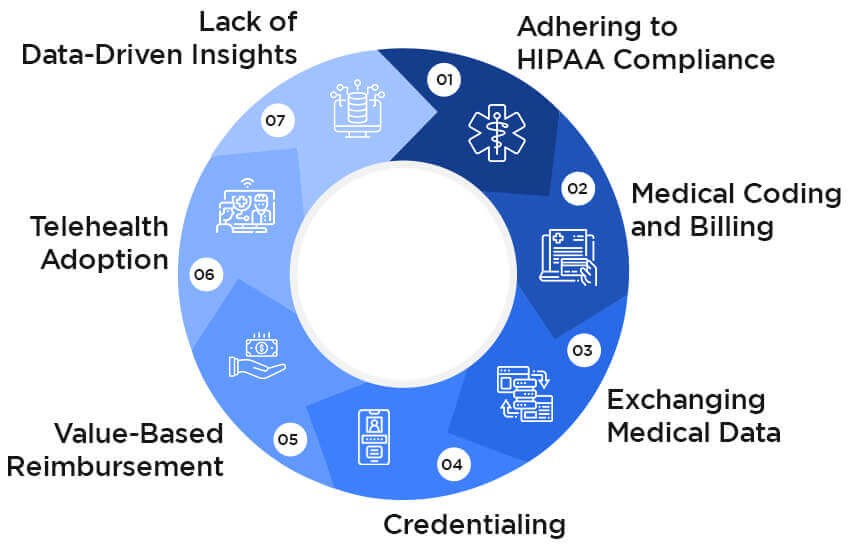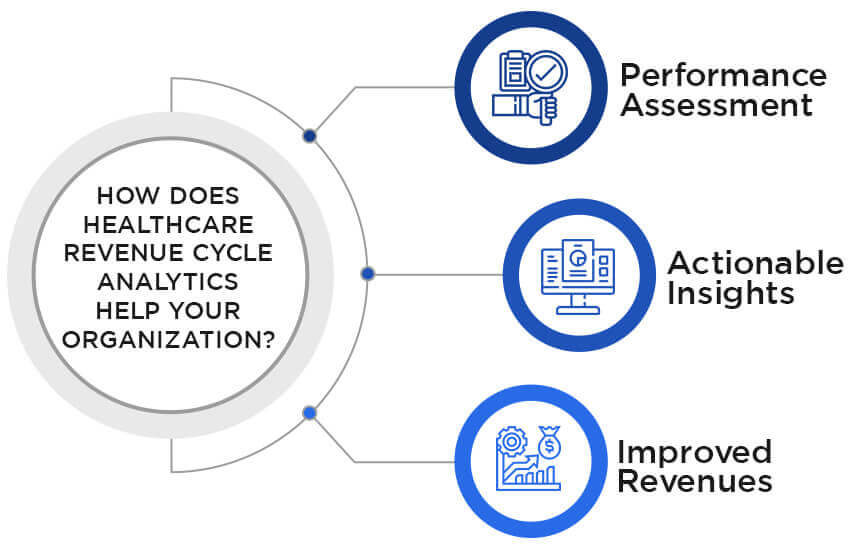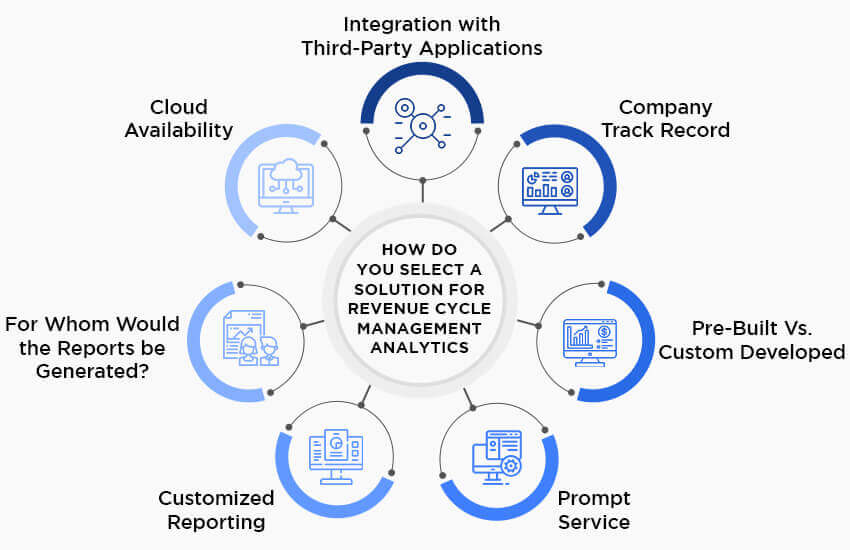Introduction:
The healthcare industry in the United States is complex, with multiple layers of regulations that are subject to changes. As a result, providing medical services and getting paid for them is often complicated. Healthcare revenue cycle management platforms (RCM platforms) streamline this process and reduce labour costs.
However, if providers want to derive more revenue from existing workflows, clinical data analytics is what they need. Healthcare revenue cycle analytics analyze the entire lifecycle of revenues right from a patient’s appointment to final payment. Doing so reveals essential information about the workflows in revenue generation. These, in turn, help providers and healthcare executives to know where they can make changes to speed up their revenues.
Challenges in Healthcare Revenue Cycles

1. Adhering to HIPAA Compliance
Patient data is a highly coveted target for cybercriminals. As a result, providers must meet stringent guidelines to safeguard patients’ health data. Software for revenue cycle analytics, patient engagement systems, and electronic health records must be protected by HIPAA compliant digital security.
2. Medical Coding and Billing
Medical coding is an integral part of the revenue cycle in healthcare, and it needs to be free of errors. Mistakes in coding result in claims being rejected, which holds up the revenue cycle process. Large hospitals often deal with large workloads, which makes coding and billing prone to errors.
3. Exchanging Medical Data
Exchanging patient data or healthcare interoperability involves pulling up patient health records to decide medication or treatments. However, data stored in different health systems make electronic data exchange extremely difficult for clinicians, affecting care and the overall revenue cycle process.
4. Credentialing
Credentialing is crucial in revenue cycle management in medical billing. Credentialing means that a provider is associated with a payer, and if this isn’t done, payers often tend to hold or even deny payments. In other words, RCM in healthcare is heavily dependent on credentialing.
5. Value-Based Reimbursement
The existing fee-for-service model drives up care costs since it incentivizes physicians to provide many services and bill for all of them. This has prompted growing calls to implement a value-based approach to reimbursements. This model would base the payments to providers on patient outcomes. However, it is difficult to quantify what can be billed and how much.
Although the value-based model sounds good, implementing it has been challenging. Furthermore, billing for it would require changes to existing models for RCM in healthcare, as the criteria would change. Needless to point out, it would also make healthcare revenue cycle analytics more difficult.
6. Telehealth Adoption
Telehealth is the hottest topic in the healthcare industry. It involves delivering medical services remotely using digital and telecommunication technologies. While it became highly popular during the pandemic, its usage waned rapidly after things returned to normal. Furthermore, many payers refused to acknowledge telehealth services as the same as in-person clinical ones. As a result, reimbursements for remote care services declined faster.
In light of the mixed reception of telehealth among payers, providers are reluctant to provide remote care services. Billing for these services is growing to challenge healthcare revenue cycle activities.
7. Lack of Data-Driven Insights
Healthcare revenue cycle management is a complex process with multiple workflows. It only grows in complexity as an organization grows larger. The data generated from these activities can illuminate the reasons for inefficiencies. However, many hospitals often face difficulty obtaining the required data due to disparate systems and siloed information.
Operational data from revenue cycle management in healthcare will pinpoint the causes for claim denials, loss of revenues, delayed reimbursements, most common coding errors, problems with compliance, and so on. Knowing the cause of these problems will help hospital managers to address them properly and boost operational productivity.
Other challenges in healthcare revenue management include claims verification and resubmission. Providers are well aware of the bureaucratic hurdles in case of claim denials, and how long it could take to get through.
However, clinical informatics solutions that also include healthcare revenue cycle analytics have been known to help clinicians identify problems in their RCM system and contain losses in revenue. Let’s look at how RCM analytics can help healthcare organizations maximize their incomes.
How Does Healthcare Revenue Cycle Analytics Help Your Organization?

Healthcare revenue cycle analytics solutions tell you more about your billing workflows than you would probably have imagined. Moreover, here’s how analytics can boost your revenues –
1. Performance Assessment
Income for hospitals and clinics comes from coding, claims, reimbursements, and billing, including out-of-pocket charges. Error in them directly affects the revenue cycle management process. But a suitable solution for revenue cycle analytics assesses the steps and produces essential clues that help streamline the process.
As a result, staff responsible for revenue cycle activities know where they can improve and make changes to their workflow. A detailed step-by-step breakdown of financial activities at hospitals lends better clarity and perspective on doing things.
2. Actionable Insights
This is perhaps the biggest advantage of having a healthcare analytics solution alongside revenue cycle analytics software. It reveals essential insights about the entire workflow of the hospital, both clinical and non-clinical. These would enable administrators and medical providers to know where they’re losing revenue and what can be done about it.
E.g., if a medical facility faces greater claims denials, a healthcare revenue cycle management software with analytics can help pinpoint the problem with submissions. This allows the staff to make improvements and reduce rejections.
The above example could also apply to the workflows of any department – coding, credentialing, or billing. Revenue cycle solutions with intelligent analytics provide actionable insights into how you can maximize your productivity using existing resources.
3. Improved Revenues
In light of the abovementioned benefits, integrated healthcare systems with RCM health analytics platforms improve incomes. This is achieved by maximizing staff productivity and reducing errors, thereby saving time to see more patients.
The result – better patient experience as well as improved care delivery.
How Do You Select a Solution for Revenue Cycle Management Analytics?

Healthcare, just as many other industries, has benefitted from analytics. So if you’re a medical professional looking for a healthcare revenue cycle analytics software, here are some things you need to look out for –
1. Integration with Third-Party Applications
Integrated healthcare systems need to work seamlessly with a wide array of custom healthcare solutions. This also includes software for revenue cycle management analysis. The integration will enable necessary data exchange between different applications, allowing for superior analytics.
The result would be a complete bird’s eye view of all the workflows in a hospital, empowering clinicians with insights to make informed decisions about integrated care management. A lack of integration of healthcare RCM would only reduce efficiency and produce inaccurate analysis.
2. Company Track Record
The track record of the company selling the healthcare revenue cycle analytics software is important. It is important to know about the company, its reputation, share of the market, duration in the industry, and so on. These factors indicate the company’s proficiency and how hospitals and clinics have received its products.
Providers or hospital executives can visit other organizations to see a revenue cycle management analytics software function and make a decision. It is also important to view the reviews of all the company’s products, both positive and negative ones. Such research is essential for making an informed decision before investing considerable money in the required software.
3. Pre-Built Vs. Custom Developed
A pre-built revenue cycle management software will be mass-produced by companies with a generic set of features suitable for assessing healthcare revenue cycle workflows. This type of solution is cheaper and faster to obtain and implement. However, it will have features different from a hospital’s requirements, prompting a change in established workflows.
On the other hand, custom healthcare revenue cycle analytics software will be developed according to a hospital’s specific requirements. It will be built after an assessment of workflows and will be more expensive. Additionally, its development will take longer as it would need a separate process lifecycle. But on the upside, it will be exactly suited for a hospital’s workflows, and the staff won’t have to spend too much time getting used to it.
4. Prompt Service
As a rule of thumb, software services must be quick and efficient. It is doubly important when it comes to healthcare providers’ solutions—the functionality of medical software impacts clinical decisions.
So, make sure that the company selling the medical revenue cycle management software has a good track record. Don’t be afraid of asking for case studies from your vendor, and it’s usually a good sign of competence and market know-how. Look for signs of prompt service and timely upgrades. Good software with poor customer support is a bad investment in the long run.
5. Customized Reporting
Healthcare automation solutions like those for assessing revenue cycles often deal with large amounts of data. The bigger the healthcare organization, the more the data is fed to RCM solutions. As a result, the reports might be much for a single clinical administrator to handle.
However, if a healthcare revenue cycle analytics software offers customized reporting, you could view assessments of individual workflows. It means that you can get detailed summaries of claims, reimbursements, coding, etc., individually. This allows for better compartmentalization and accurate decision-making.
Additionally, advances in cloud computing in healthcare have even enabled the platform to be viewed from personal devices. Mhealth applications can allow you to view smartphone reports while on the go.
This is one feature that you’d want to have.
6. For Whom Would the Reports be Generated?
Targeted, role-specific reporting becomes increasingly essential as a medical organization grows. The CFO might want to view the overall financial health, while someone in charge of billing and reimbursements might want to look at claims and accounts receivables. Each of these individuals would want different things from common healthcare revenue cycle management solutions. They must be able to access relevant reports that suit their obligations. Moreover, it would also engender better medical records management as there’ll be optimized workflows, making it easier for patient data entry.
7. Cloud Availability
A cloud-hosted software for revenue cycle analytics for hospitals would eliminate the need to be installed on-premises. In other words, the software it is processing and all the relevant data would be in a remote location. The application and its data can only be accessed by authorized personnel securely.
The best part of a cloud-hosted application is that it removes the need for on-premises hardware. The cloud services provider would handle all the IT infrastructure related to its functioning and data. Healthcare revenue cycle management software based on the cloud is especially helpful for large hospitals. Such an organization would generate vast amounts of data and likely need a varying storage capacity. Cloud-based software allows applications to be scaled-up or down based on requirements.
The Role Of Healthcare Revenue Cycle Analytics In The Future Of The Industry
Data analytics is becoming the buzzword in the healthcare software industry and across all industries. Experts in data analytics have concluded that every major company in every industry would leverage it. Healthcare is no exception.
The healthcare industry in the United States is worth nearly $4 trillion. So, it is not surprising that assessing the data from all the operations would benefit provider organizations and every stakeholder involved. Needless to point out, healthcare revenue cycle analytics is the center of the focus when it comes to analytics in healthcare.
The whole process flow of revenue cycle management in healthcare is highly complex and bureaucratic. It involves verifying insurance plans, coding the clinical encounter, preparing claims, processing payments, potential denials, rejections, etc. Assessing this entire cycle of events will reveal plenty of insights about the process’s pain points. By knowing the reasons for inefficiencies, providers and administrators can take steps to boost productivity.
Preparing claims and medical coding are some of the most error-prone in the healthcare RCM lifecycle. Problems in these steps lead to a significant portion of the claim denials. Additionally, healthcare revenue cycle analytics can identify the reasons for high costs and help hospitals bring them down.
The biggest takeaway from RCM analytics is its insight into everyday operations. It helps cut across the bureaucracy and the labyrinth of procedures to produce valuable business intelligence on how things can be improved.
Revenue cycle analytics not only has a future in the healthcare industry but is the future. Everything will be data-driven, and the quality of the insights will depend on the data processing quality. As technology plays an increasingly bigger role in healthcare, it only increases the importance of data analytics for optimizing the technology.
Conclusion
Healthcare revenue cycle analytics is rapidly recognized as a must-have for medical organizations. Improving the financial workflows of a hospital allows providers to focus better on patient care. Moreover, by allowing medical professionals to streamline many of their activities, health care revenue cycle solutions end up bolstering most of the workflows. As a result, there’s better patient experience, up-to-date medical records with billing histories, superior care, enhanced population health management, while revenues are maximized.
OSP is a trusted software development company that delivers bespoke solutions as per your business needs. Connect with us to hire the best talents in the industry to build enterprise-grade software.

How can we help?
Fill out the short form below or call us at (888) 846-5382
Looking for software solutions to build your product?
Let's discuss your software solutions for your product in our free development acceleration call!
Get In Touch arrow_forwardDiscuss Your Project Handover with a team of expert Book a free consultation arrow_forward
About Author

Written by Riken Shah linkedin
Riken's work motto is to help healthcare providers use technological advancements to make healthcare easily accessible to all stakeholders, from providers to patients. Under his leadership and guidance, OSP Labs has successfully developed over 600 customized software solutions for 200+ healthcare clients across continents.

















